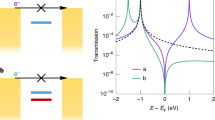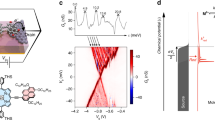Abstract
According to Kirchhoff's circuit laws, the net conductance of two parallel components in an electronic circuit is the sum of the individual conductances. However, when the circuit dimensions are comparable to the electronic phase coherence length, quantum interference effects play a critical role1, as exemplified by the Aharonov–Bohm effect in metal rings2,3. At the molecular scale, interference effects dramatically reduce the electron transfer rate through a meta-connected benzene ring when compared with a para-connected benzene ring4,5. For longer conjugated and cross-conjugated molecules, destructive interference effects have been observed in the tunnelling conductance through molecular junctions6,7,8,9,10. Here, we investigate the conductance superposition law for parallel components in single-molecule circuits, particularly the role of interference. We synthesize a series of molecular systems that contain either one backbone or two backbones in parallel, bonded together cofacially by a common linker on each end. Single-molecule conductance measurements and transport calculations based on density functional theory show that the conductance of a double-backbone molecular junction can be more than twice that of a single-backbone junction, providing clear evidence for constructive interference.
This is a preview of subscription content, access via your institution
Access options
Subscribe to this journal
Receive 12 print issues and online access
$259.00 per year
only $21.58 per issue
Buy this article
- Purchase on Springer Link
- Instant access to full article PDF
Prices may be subject to local taxes which are calculated during checkout



Similar content being viewed by others
References
Beenakker, C. W. J. & van Houten, H. Quantum transport in semiconductor nanostructures. Solid State Phys. 44, 1–228 (1991).
Aharonov, Y. & Bohm, D. Significance of electromagnetic potentials in the quantum theory. Phys. Rev. 115, 485–491 (1959).
Webb, R. A., Washburn, S., Umbach, C. P. & Laibowitz, R. B. Observation of h/e Aharonov–Bohm oscillations in normal-metal rings. Phys. Rev. Lett. 54, 2696–2699 (1985).
Sautet, P. & Joachim, C. Electronic interference produced by a benzene embedded in a polyacetylene chain. Chem. Phys. Lett. 153, 511–516 (1988).
Patoux, C., Coudret, C., Launay, J-P., Joachim, C. & Gourdon, A. Topological effects on intramolecular electron transfer via quantum interference. Inorg. Chem. 36, 5037–5049 (1997).
Mayor, M. et al. Electric current through a molecular rod—relevance of the position of the anchor groups. Angew. Chem. Int. Ed. 42, 5834–5838 (2003).
Kiguchi, M., Nakamura, H., Takahashi, Y., Takahashi, T. & Ohto, T. Effect of anchoring group position on formation and conductance of a single disubstituted benzene molecule bridging Au electrodes: change of conductive molecular orbital and electron pathway. J. Phys. Chem. C 114, 22254–22261 (2010).
Fracasso, D., Valkenier, H., Hummelen, J. C., Solomon, G. C. & Chiechi, R. C. Evidence for quantum interference in SAMs of arylethynylene thiolates in tunneling junctions with eutectic Ga–In (EGaIn) top-contacts. J. Am. Chem. Soc. 133, 9556–9563 (2011).
Guedon, C. M. et al. Observation of quantum interference in molecular charge transport. Nature Nanotech. 7, 305–309 (2012).
Aradhya, S. V. et al. Dissecting contact mechanics from quantum interference in single-molecule junctions of stilbene derivatives. Nano Lett. 12, 1643–1647 (2012).
Yaliraki, S. N. & Ratner, M. A. Molecule–interface coupling effects on electronic transport in molecular wires. J. Chem. Phys. 109, 5036–5043 (1998).
Magoga, M. & Joachim, C. Conductance of molecular wires connected or bonded in parallel. Phys. Rev. B 59, 16011–16021 (1999).
Lang, N. D. & Avouris, P. Electrical conductance of parallel atomic wires. Phys. Rev. B 62, 7325–7329 (2000).
Liu, R., Ke, S-H., Baranger, H. U. & Yang, W. Intermolecular effect in molecular electronics. J. Chem. Phys. 122, 044703 (2005).
Landau, A., Kronik, L. & Nitzan, A. Cooperative effects in molecular conduction. J. Comput. Theor. Nanosci. 5, 535–544 (2008).
Reuter, M. G., Seideman, T. & Ratner, M. A. Molecular conduction through adlayers: cooperative effects can help or hamper electron transport. Nano Lett. 11, 4693–4696 (2011).
Park, Y. S. et al. Contact chemistry and single-molecule conductance: a comparison of phosphines, methyl sulfides, and amines. J. Am. Chem. Soc. 129, 15768–15769 (2007).
Park, Y. S. et al. Frustrated rotations in single-molecule junctions. J. Am. Chem. Soc. 131, 10820–10821 (2009).
Xu, B. Q. & Tao, N. J. Measurement of single-molecule resistance by repeated formation of molecular junctions. Science 301, 1221–1223 (2003).
Quek, S. Y. et al. Mechanically controlled binary conductance switching of a single-molecule junction. Nature Nanotech. 4, 230–234 (2009).
Kamenetska, M. et al. Conductance and geometry of pyridine-linked single-molecule junctions. J. Am. Chem. Soc. 132, 6817–6821 (2010).
Martin, C. A. et al. Fullerene-based anchoring groups for molecular electronics. J. Am. Chem. Soc. 130, 13198–13199 (2008).
Quek, S. Y. et al. Amine-gold linked single-molecule circuits: experiment and theory. Nano Lett. 7, 3477–3482 (2007).
Quek, S. Y., Choi, H. J., Louie, S. G. & Neaton, J. B. Length dependence of conductance in aromatic single-molecule junctions. Nano Lett. 9, 3949–3953 (2009).
Strange, M., Rostgaard, C., Hakkinen, H. & Thygesen, K. S. Self-consistent GW calculations of electronic transport in thiol- and amine-linked molecular junctions. Phys. Rev. B 83, 115108 (2011).
Venkataraman, L. et al. Single-molecule circuits with well-defined molecular conductance. Nano Lett. 6, 458–462 (2006).
Soler, J. M. et al. The SIESTA method for ab initio order-N materials simulation. J. Phys. Condens. Matter 14, 2745–2779 (2002).
Brandbyge, M., Mozos, J. L., Ordejon, P., Taylor, J. & Stokbro, K. Density-functional method for nonequilibrium electron transport. Phys. Rev. B 65, 165401 (2002).
Perdew, J. P., Burke, K. & Ernzerhof, M. Generalized gradient approximation made simple. Phys. Rev. Lett. 77, 3865–3868 (1996).
Paulsson, M. & Brandbyge, M. Transmission eigenchannels from nonequilibrium Green's functions. Phys. Rev. B 76, 115117 (2007).
Acknowledgements
This work was supported primarily by the Nanoscale Science and Engineering Initiative of the National Science Foundation (NSF, CHE-0641523), the New York State Office of Science, Technology, and Academic Research (NYSTAR) and an NSF Career Award to L.V. (CHE-07-44185). L.V. also thanks the Packard Foundation for support. This work was carried out in part at the Center for Functional Nanomaterials, Brookhaven National Laboratory, which is supported by the US Department of Energy, Office of Basic Energy Sciences (contract no. DE-AC02-98CH10886). R.S. acknowledges financial support from the Canadian postdoctoral fellowship FQRNT programme. S.T.S. acknowledges support from an Arun Guthikonda Memorial graduate fellowship. The authors thank the NSF (CHE-0619638) for the acquisition of an X-ray diffractometer, and G. Parkin and W. Sattler for obtaining our crystal structures.
Author information
Authors and Affiliations
Contributions
The experiments were conceived by R.S., S.S., M.K., R.B. and L.V. Theory and calculations were conceived by H.V. and M.S.H. Synthesis and chemical analysis were performed by R.S. and S.S. Conductance measurements and analysis were performed by M.K and L.V. Calculations were performed by H.V. The manuscript was written by H.V., L.V. and M.S.H., with comments and input from all other authors.
Corresponding authors
Ethics declarations
Competing interests
The authors declare no competing financial interests.
Supplementary information
Supplementary information
Supplementary information (PDF 7417 kb)
Rights and permissions
About this article
Cite this article
Vazquez, H., Skouta, R., Schneebeli, S. et al. Probing the conductance superposition law in single-molecule circuits with parallel paths. Nature Nanotech 7, 663–667 (2012). https://doi.org/10.1038/nnano.2012.147
Received:
Accepted:
Published:
Issue Date:
DOI: https://doi.org/10.1038/nnano.2012.147
This article is cited by
-
Collection of unconventional transport phenomena: natural obstacle or vibrant guiding principle for the design of molecular junctions?
AAPPS Bulletin (2024)
-
Graphene–molecule–graphene single-molecule junctions to detect electronic reactions at the molecular scale
Nature Protocols (2023)
-
Nanoscale molecular rectifiers
Nature Reviews Chemistry (2023)
-
Remote creation of quantum coherence via indefinite causal order
Quantum Information Processing (2023)
-
Molecular ensemble junctions with inter-molecular quantum interference
Nature Communications (2022)



